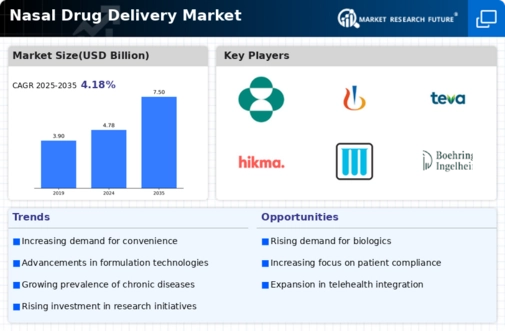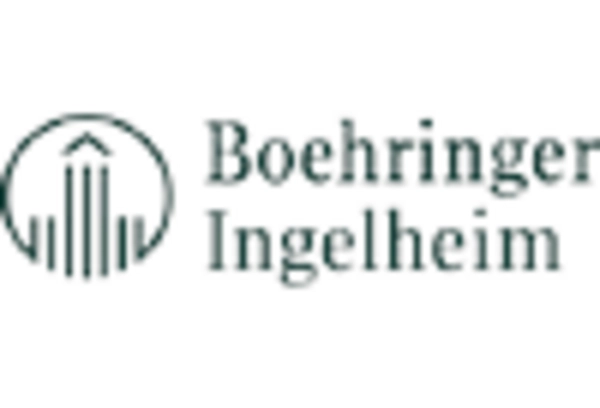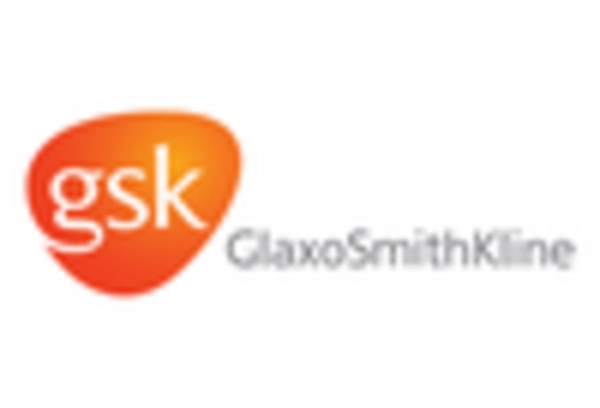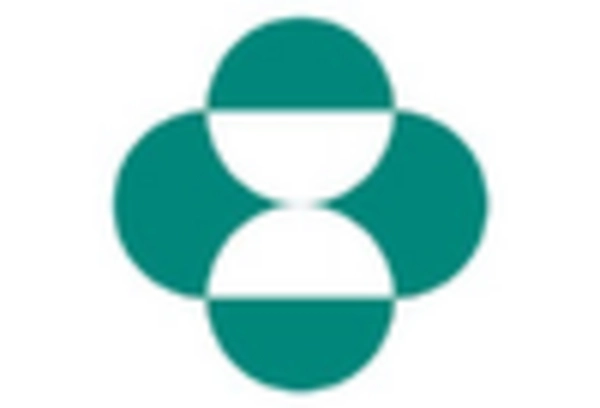Nasal Sprays
Nasal Drops
Nasal Inhalers
Powder Nasal Delivery Devices
Liquid Formulations
Semi-solid Formulations
Solid Formulation
Allergy
Migraine
Nasal Congestion
Other
Hospitals
Clinics
Homecare
North America
Europe
South America
Asia Pacific
Middle East and Africa
North America Outlook (USD Billion, 2019-2035)
North America Nasal Drug Delivery Market by Device Type
Nasal Sprays
Nasal Drops
Nasal Inhalers
Powder Nasal Delivery Devices
North America Nasal Drug Delivery Market by Formulation Type
Liquid Formulations
Semi-solid Formulations
Solid Formulations
North America Nasal Drug Delivery Market by Indication Type
Allergy
Migraine
Nasal Congestion
Other
North America Nasal Drug Delivery Market by End User Type
Hospitals
Clinics
Homecare
North America Nasal Drug Delivery Market by Regional Type
US
Canada
US Outlook (USD Billion, 2019-2035)
US Nasal Drug Delivery Market by Device Type
Nasal Sprays
Nasal Drops
Nasal Inhalers
Powder Nasal Delivery Devices
US Nasal Drug Delivery Market by Formulation Type
Liquid Formulations
Semi-solid Formulations
Solid Formulations
US Nasal Drug Delivery Market by Indication Type
Allergy
Migraine
Nasal Congestion
Other
US Nasal Drug Delivery Market by End User Type
Hospitals
Clinics
Homecare
CANADA Outlook (USD Billion, 2019-2035)
CANADA Nasal Drug Delivery Market by Device Type
Nasal Sprays
Nasal Drops
Nasal Inhalers
Powder Nasal Delivery Devices
CANADA Nasal Drug Delivery Market by Formulation Type
Liquid Formulations
Semi-solid Formulations
Solid Formulations
CANADA Nasal Drug Delivery Market by Indication Type
Allergy
Migraine
Nasal Congestion
Other
CANADA Nasal Drug Delivery Market by End User Type
Hospitals
Clinics
Homecare
Europe Outlook (USD Billion, 2019-2035)
Europe Nasal Drug Delivery Market by Device Type
Nasal Sprays
Nasal Drops
Nasal Inhalers
Powder Nasal Delivery Devices
Europe Nasal Drug Delivery Market by Formulation Type
Liquid Formulations
Semi-solid Formulations
Solid Formulations
Europe Nasal Drug Delivery Market by Indication Type
Allergy
Migraine
Nasal Congestion
Other
Europe Nasal Drug Delivery Market by End User Type
Hospitals
Clinics
Homecare
Europe Nasal Drug Delivery Market by Regional Type
Germany
UK
France
Russia
Italy
Spain
Rest of Europe
GERMANY Outlook (USD Billion, 2019-2035)
GERMANY Nasal Drug Delivery Market by Device Type
Nasal Sprays
Nasal Drops
Nasal Inhalers
Powder Nasal Delivery Devices
GERMANY Nasal Drug Delivery Market by Formulation Type
Liquid Formulations
Semi-solid Formulations
Solid Formulations
GERMANY Nasal Drug Delivery Market by Indication Type
Allergy
Migraine
Nasal Congestion
Other
GERMANY Nasal Drug Delivery Market by End User Type
Hospitals
Clinics
Homecare
UK Outlook (USD Billion, 2019-2035)
UK Nasal Drug Delivery Market by Device Type
Nasal Sprays
Nasal Drops
Nasal Inhalers
Powder Nasal Delivery Devices
UK Nasal Drug Delivery Market by Formulation Type
Liquid Formulations
Semi-solid Formulations
Solid Formulations
UK Nasal Drug Delivery Market by Indication Type
Allergy
Migraine
Nasal Congestion
Other
UK Nasal Drug Delivery Market by End User Type
Hospitals
Clinics
Homecare
FRANCE Outlook (USD Billion, 2019-2035)
FRANCE Nasal Drug Delivery Market by Device Type
Nasal Sprays
Nasal Drops
Nasal Inhalers
Powder Nasal Delivery Devices
FRANCE Nasal Drug Delivery Market by Formulation Type
Liquid Formulations
Semi-solid Formulations
Solid Formulations
FRANCE Nasal Drug Delivery Market by Indication Type
Allergy
Migraine
Nasal Congestion
Other
FRANCE Nasal Drug Delivery Market by End User Type
Hospitals
Clinics
Homecare
RUSSIA Outlook (USD Billion, 2019-2035)
RUSSIA Nasal Drug Delivery Market by Device Type
Nasal Sprays
Nasal Drops
Nasal Inhalers
Powder Nasal Delivery Devices
RUSSIA Nasal Drug Delivery Market by Formulation Type
Liquid Formulations
Semi-solid Formulations
Solid Formulations
RUSSIA Nasal Drug Delivery Market by Indication Type
Allergy
Migraine
Nasal Congestion
Other
RUSSIA Nasal Drug Delivery Market by End User Type
Hospitals
Clinics
Homecare
ITALY Outlook (USD Billion, 2019-2035)
ITALY Nasal Drug Delivery Market by Device Type
Nasal Sprays
Nasal Drops
Nasal Inhalers
Powder Nasal Delivery Devices
ITALY Nasal Drug Delivery Market by Formulation Type
Liquid Formulations
Semi-solid Formulations
Solid Formulations
ITALY Nasal Drug Delivery Market by Indication Type
Allergy
Migraine
Nasal Congestion
Other
ITALY Nasal Drug Delivery Market by End User Type
Hospitals
Clinics
Homecare
SPAIN Outlook (USD Billion, 2019-2035)
SPAIN Nasal Drug Delivery Market by Device Type
Nasal Sprays
Nasal Drops
Nasal Inhalers
Powder Nasal Delivery Devices
SPAIN Nasal Drug Delivery Market by Formulation Type
Liquid Formulations
Semi-solid Formulations
Solid Formulations
SPAIN Nasal Drug Delivery Market by Indication Type
Allergy
Migraine
Nasal Congestion
Other
SPAIN Nasal Drug Delivery Market by End User Type
Hospitals
Clinics
Homecare
REST OF EUROPE Outlook (USD Billion, 2019-2035)
REST OF EUROPE Nasal Drug Delivery Market by Device Type
Nasal Sprays
Nasal Drops
Nasal Inhalers
Powder Nasal Delivery Devices
REST OF EUROPE Nasal Drug Delivery Market by Formulation Type
Liquid Formulations
Semi-solid Formulations
Solid Formulations
REST OF EUROPE Nasal Drug Delivery Market by Indication Type
Allergy
Migraine
Nasal Congestion
Other
REST OF EUROPE Nasal Drug Delivery Market by End User Type
Hospitals
Clinics
Homecare
APAC Outlook (USD Billion, 2019-2035)
APAC Nasal Drug Delivery Market by Device Type
Nasal Sprays
Nasal Drops
Nasal Inhalers
Powder Nasal Delivery Devices
APAC Nasal Drug Delivery Market by Formulation Type
Liquid Formulations
Semi-solid Formulations
Solid Formulations
APAC Nasal Drug Delivery Market by Indication Type
Allergy
Migraine
Nasal Congestion
Other
APAC Nasal Drug Delivery Market by End User Type
Hospitals
Clinics
Homecare
APAC Nasal Drug Delivery Market by Regional Type
China
India
Japan
South Korea
Malaysia
Thailand
Indonesia
Rest of APAC
CHINA Outlook (USD Billion, 2019-2035)
CHINA Nasal Drug Delivery Market by Device Type
Nasal Sprays
Nasal Drops
Nasal Inhalers
Powder Nasal Delivery Devices
CHINA Nasal Drug Delivery Market by Formulation Type
Liquid Formulations
Semi-solid Formulations
Solid Formulations
CHINA Nasal Drug Delivery Market by Indication Type
Allergy
Migraine
Nasal Congestion
Other
CHINA Nasal Drug Delivery Market by End User Type
Hospitals
Clinics
Homecare
INDIA Outlook (USD Billion, 2019-2035)
INDIA Nasal Drug Delivery Market by Device Type
Nasal Sprays
Nasal Drops
Nasal Inhalers
Powder Nasal Delivery Devices
INDIA Nasal Drug Delivery Market by Formulation Type
Liquid Formulations
Semi-solid Formulations
Solid Formulations
INDIA Nasal Drug Delivery Market by Indication Type
Allergy
Migraine
Nasal Congestion
Other
INDIA Nasal Drug Delivery Market by End User Type
Hospitals
Clinics
Homecare
JAPAN Outlook (USD Billion, 2019-2035)
JAPAN Nasal Drug Delivery Market by Device Type
Nasal Sprays
Nasal Drops
Nasal Inhalers
Powder Nasal Delivery Devices
JAPAN Nasal Drug Delivery Market by Formulation Type
Liquid Formulations
Semi-solid Formulations
Solid Formulations
JAPAN Nasal Drug Delivery Market by Indication Type
Allergy
Migraine
Nasal Congestion
Other
JAPAN Nasal Drug Delivery Market by End User Type
Hospitals
Clinics
Homecare
SOUTH KOREA Outlook (USD Billion, 2019-2035)
SOUTH KOREA Nasal Drug Delivery Market by Device Type
Nasal Sprays
Nasal Drops
Nasal Inhalers
Powder Nasal Delivery Devices
SOUTH KOREA Nasal Drug Delivery Market by Formulation Type
Liquid Formulations
Semi-solid Formulations
Solid Formulations
SOUTH KOREA Nasal Drug Delivery Market by Indication Type
Allergy
Migraine
Nasal Congestion
Other
SOUTH KOREA Nasal Drug Delivery Market by End User Type
Hospitals
Clinics
Homecare
MALAYSIA Outlook (USD Billion, 2019-2035)
MALAYSIA Nasal Drug Delivery Market by Device Type
Nasal Sprays
Nasal Drops
Nasal Inhalers
Powder Nasal Delivery Devices
MALAYSIA Nasal Drug Delivery Market by Formulation Type
Liquid Formulations
Semi-solid Formulations
Solid Formulations
MALAYSIA Nasal Drug Delivery Market by Indication Type
Allergy
Migraine
Nasal Congestion
Other
MALAYSIA Nasal Drug Delivery Market by End User Type
Hospitals
Clinics
Homecare
THAILAND Outlook (USD Billion, 2019-2035)
THAILAND Nasal Drug Delivery Market by Device Type
Nasal Sprays
Nasal Drops
Nasal Inhalers
Powder Nasal Delivery Devices
THAILAND Nasal Drug Delivery Market by Formulation Type
Liquid Formulations
Semi-solid Formulations
Solid Formulations
THAILAND Nasal Drug Delivery Market by Indication Type
Allergy
Migraine
Nasal Congestion
Other
THAILAND Nasal Drug Delivery Market by End User Type
Hospitals
Clinics
Homecare
INDONESIA Outlook (USD Billion, 2019-2035)
INDONESIA Nasal Drug Delivery Market by Device Type
Nasal Sprays
Nasal Drops
Nasal Inhalers
Powder Nasal Delivery Devices
INDONESIA Nasal Drug Delivery Market by Formulation Type
Liquid Formulations
Semi-solid Formulations
Solid Formulations
INDONESIA Nasal Drug Delivery Market by Indication Type
Allergy
Migraine
Nasal Congestion
Other
INDONESIA Nasal Drug Delivery Market by End User Type
Hospitals
Clinics
Homecare
REST OF APAC Outlook (USD Billion, 2019-2035)
REST OF APAC Nasal Drug Delivery Market by Device Type
Nasal Sprays
Nasal Drops
Nasal Inhalers
Powder Nasal Delivery Devices
REST OF APAC Nasal Drug Delivery Market by Formulation Type
Liquid Formulations
Semi-solid Formulations
Solid Formulations
REST OF APAC Nasal Drug Delivery Market by Indication Type
Allergy
Migraine
Nasal Congestion
Other
REST OF APAC Nasal Drug Delivery Market by End User Type
Hospitals
Clinics
Homecare
South America Outlook (USD Billion, 2019-2035)
South America Nasal Drug Delivery Market by Device Type
Nasal Sprays
Nasal Drops
Nasal Inhalers
Powder Nasal Delivery Devices
South America Nasal Drug Delivery Market by Formulation Type
Liquid Formulations
Semi-solid Formulations
Solid Formulations
South America Nasal Drug Delivery Market by Indication Type
Allergy
Migraine
Nasal Congestion
Other
South America Nasal Drug Delivery Market by End User Type
Hospitals
Clinics
Homecare
South America Nasal Drug Delivery Market by Regional Type
Brazil
Mexico
Argentina
Rest of South America
BRAZIL Outlook (USD Billion, 2019-2035)
BRAZIL Nasal Drug Delivery Market by Device Type
Nasal Sprays
Nasal Drops
Nasal Inhalers
Powder Nasal Delivery Devices
BRAZIL Nasal Drug Delivery Market by Formulation Type
Liquid Formulations
Semi-solid Formulations
Solid Formulations
BRAZIL Nasal Drug Delivery Market by Indication Type
Allergy
Migraine
Nasal Congestion
Other
BRAZIL Nasal Drug Delivery Market by End User Type
Hospitals
Clinics
Homecare
MEXICO Outlook (USD Billion, 2019-2035)
MEXICO Nasal Drug Delivery Market by Device Type
Nasal Sprays
Nasal Drops
Nasal Inhalers
Powder Nasal Delivery Devices
MEXICO Nasal Drug Delivery Market by Formulation Type
Liquid Formulations
Semi-solid Formulations
Solid Formulations
MEXICO Nasal Drug Delivery Market by Indication Type
Allergy
Migraine
Nasal Congestion
Other
MEXICO Nasal Drug Delivery Market by End User Type
Hospitals
Clinics
Homecare
ARGENTINA Outlook (USD Billion, 2019-2035)
ARGENTINA Nasal Drug Delivery Market by Device Type
Nasal Sprays
Nasal Drops
Nasal Inhalers
Powder Nasal Delivery Devices
ARGENTINA Nasal Drug Delivery Market by Formulation Type
Liquid Formulations
Semi-solid Formulations
Solid Formulations
ARGENTINA Nasal Drug Delivery Market by Indication Type
Allergy
Migraine
Nasal Congestion
Other
ARGENTINA Nasal Drug Delivery Market by End User Type
Hospitals
Clinics
Homecare
REST OF SOUTH AMERICA Outlook (USD Billion, 2019-2035)
REST OF SOUTH AMERICA Nasal Drug Delivery Market by Device Type
Nasal Sprays
Nasal Drops
Nasal Inhalers
Powder Nasal Delivery Devices
REST OF SOUTH AMERICA Nasal Drug Delivery Market by Formulation Type
Liquid Formulations
Semi-solid Formulations
Solid Formulations
REST OF SOUTH AMERICA Nasal Drug Delivery Market by Indication Type
Allergy
Migraine
Nasal Congestion
Other
REST OF SOUTH AMERICA Nasal Drug Delivery Market by End User Type
Hospitals
Clinics
Homecare
MEA Outlook (USD Billion, 2019-2035)
MEA Nasal Drug Delivery Market by Device Type
Nasal Sprays
Nasal Drops
Nasal Inhalers
Powder Nasal Delivery Devices
MEA Nasal Drug Delivery Market by Formulation Type
Liquid Formulations
Semi-solid Formulations
Solid Formulations
MEA Nasal Drug Delivery Market by Indication Type
Allergy
Migraine
Nasal Congestion
Other
MEA Nasal Drug Delivery Market by End User Type
Hospitals
Clinics
Homecare
MEA Nasal Drug Delivery Market by Regional Type
GCC Countries
South Africa
Rest of MEA
GCC COUNTRIES Outlook (USD Billion, 2019-2035)
GCC COUNTRIES Nasal Drug Delivery Market by Device Type
Nasal Sprays
Nasal Drops
Nasal Inhalers
Powder Nasal Delivery Devices
GCC COUNTRIES Nasal Drug Delivery Market by Formulation Type
Liquid Formulations
Semi-solid Formulations
Solid Formulations
GCC COUNTRIES Nasal Drug Delivery Market by Indication Type
Allergy
Migraine
Nasal Congestion
Other
GCC COUNTRIES Nasal Drug Delivery Market by End User Type
Hospitals
Clinics
Homecare
SOUTH AFRICA Outlook (USD Billion, 2019-2035)
SOUTH AFRICA Nasal Drug Delivery Market by Device Type
Nasal Sprays
Nasal Drops
Nasal Inhalers
Powder Nasal Delivery Devices
SOUTH AFRICA Nasal Drug Delivery Market by Formulation Type
Liquid Formulations
Semi-solid Formulations
Solid Formulations
SOUTH AFRICA Nasal Drug Delivery Market by Indication Type
Allergy
Migraine
Nasal Congestion
Other
SOUTH AFRICA Nasal Drug Delivery Market by End User Type
Hospitals
Clinics
Homecare
REST OF MEA Outlook (USD Billion, 2019-2035)
REST OF MEA Nasal Drug Delivery Market by Device Type
Nasal Sprays
Nasal Drops
Nasal Inhalers
Powder Nasal Delivery Devices
REST OF MEA Nasal Drug Delivery Market by Formulation Type
Liquid Formulations
Semi-solid Formulations
Solid Formulations
REST OF MEA Nasal Drug Delivery Market by Indication Type
Allergy
Migraine
Nasal Congestion
Other
REST OF MEA Nasal Drug Delivery Market by End User Type
Hospitals
Clinics
Homecare

















Leave a Comment